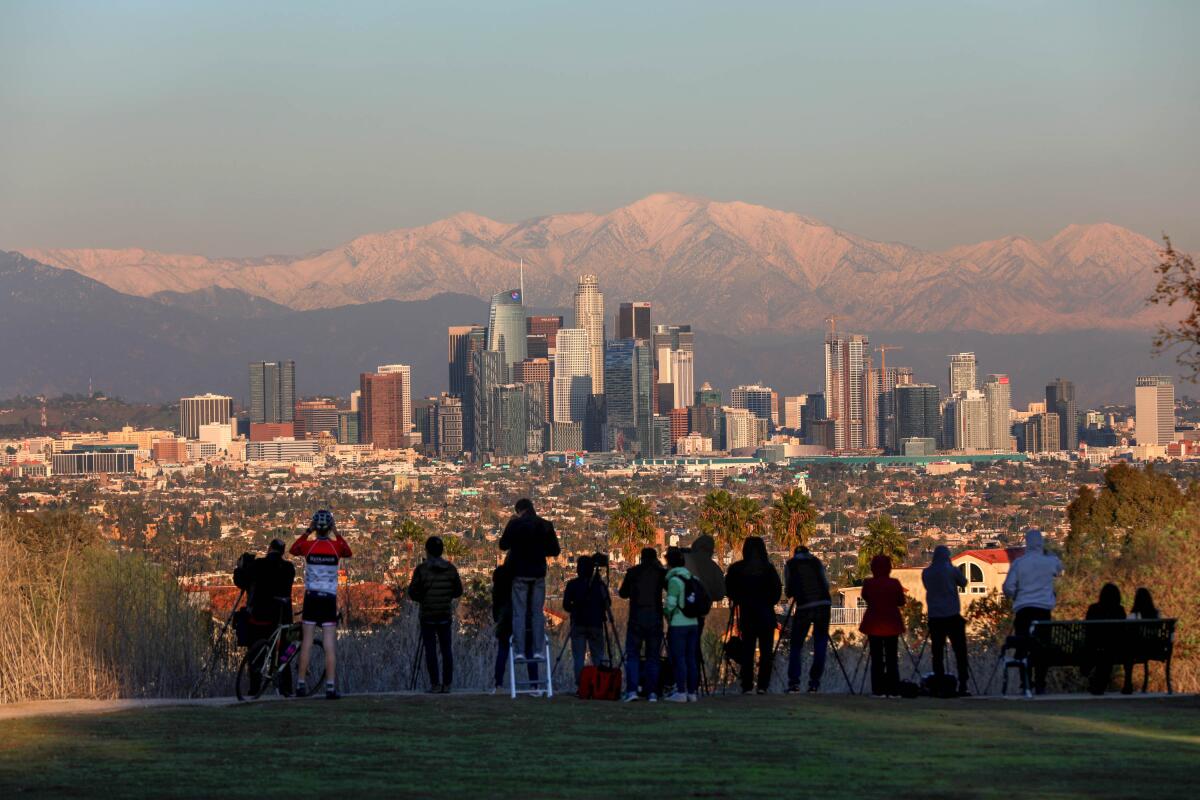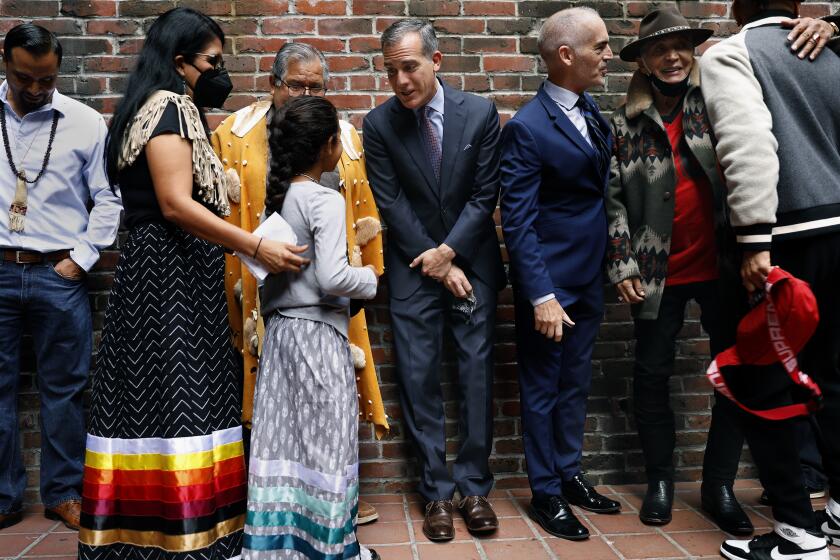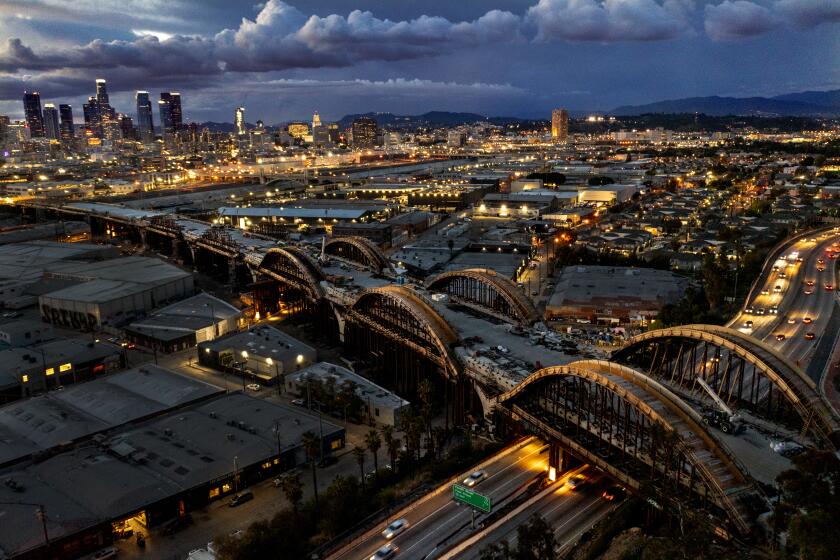Why is L.A.’s iconic skyline far from the beach — unlike Miami, Seattle and other cities?

- Share via
In summer 2021, we began asking readers to submit their most pressing business-related questions about Los Angeles and California.
Then we put the questions to a vote, allowing readers to decide which question we would answer in story form.
Our latest winner was submitted by Javier Barraza, an economics student at California State University, Los Angeles, who asked: “Why doesn’t L.A. have a skyline by the water like New York, San Francisco and Seattle?”
Not to snub Santa Monica’s Clock Tower building and other notable coastal high-rises, but L.A.’s most recognizable skyscrapers — such as the Wilshire Grand Center, U.S. Bank tower and Aon Center — lie roughly 15 miles from the Pacific.
How did L.A.’s quintessential skyline end up so far from its beaches, unlike at many other U.S. cities?
A cold storage plant in Los Angeles’ Arts District would be replaced with housing, offices, a hotel and shops in a proposed mega-development called Fourth & Central.
“I would offer a saltwater answer and a freshwater answer,” said William Deverell, a professor of history, spatial sciences and environmental studies at the University of Southern California.
The saltwater answer? L.A. lacked a deepwater harbor in the years following its founding.
“Harbor commerce and harbor development can encourage cities to build right alongside whatever ocean they’re up against,” Deverell said. “Los Angeles doesn’t have that in any particular sense until later.”
“The freshwater answer is our little but so important L.A. River,” he continued. “The L.A. River is where Indigenous people were settling up and against over millennia.”
When the Spanish colonial and ecclesiastical forces arrived in what is now the Los Angeles area, they sought out a freshwater source, as well as Indigenous people. “They’re going to find them in the Los Angeles Basin, in and around the L.A. River,” Deverell said.
Throughout California’s history, Indigenous rights were consistently and violently undermined via forced labor, religious conversion efforts, displacement and attempts at historical erasure.
“They want to implant the mission system, and they need the labor to do it,” he said. “And then, Indigenous souls to convert to Christianity. So it’s all kind of a package for them, to terrible results.”
Turning on its head one of the many myths of the American West, Los Angeles moves to correct its historical record with Native inhabitants.
The Spanish founded the pueblo of Los Angeles in 1781. They constructed a plaza, church and other buildings on a site that was adjacent to a Tongva community, said Eric Avila, a professor of history, Chicano studies and urban planning at the University of California, Los Angeles.
“By establishing the plaza there, the Spanish were trying to maximize their control over the Indigenous population,” said Avila.
So, the Spanish set down roots in what is now downtown Los Angeles. But then came the Mexican War of Independence, which resulted in Mexico gaining control of Los Angeles, and the Mexican-American War in the mid-1800s.
“The United States conquers Mexico and takes over its land,” Avila said. “In the second half of the 19th century, when Los Angeles became an American city, there was already a lively commercial center around the old Spanish pueblo.”
Today, L.A.’s skyline “exists within the original Spanish and Mexican commercial center of Los Angeles,” Avila said. “The old plaza space survived as a historic center of the city.”
L.A. Times readers are curious about weather, wildfire and relics of the Cold War, among other things.
The construction of railroad tracks connecting downtown L.A. and the Port of Los Angeles, officially founded in 1907, further reinforced downtown L.A.’s importance as a commercial center.
“That’s where the banks are. That’s where the population centers are,” Deverell said, resulting in downtown L.A.’s skyline getting a head start in development compared to other parts of L.A.
The rise of white collar work in downtown L.A. — and the invention of elevators and steel girder construction — also contributed to skyline development at the turn of the century, Deverell said.
“I think people were pretty proud of it. I think it’s like, ‘Wow, we used to be this kind of dusty crossroads. And now look at us,’” Deverell said. “It’s one of the ways in which L.A. tells the world we’ve arrived.”
The 12-story Continental Building, known as downtown L.A.’s first skyscraper, was built on Spring Street in the early 1900s. “While no longer considered a skyscraper … it was the tallest building for over fifty years,” Camille Suárez, an assistant professor of history at the California State University, Los Angeles, said via email.
Shortly after the Continental Building was erected to a height of 175 feet, Los Angeles buildings were capped at 150 feet tall, with the exception of Los Angeles City Hall. “When the ban was lifted in 1957, a building boom occurred downtown,” she said.
Of course, other factors contributed to the lack of a major skyline along L.A.’s coastline — space being one of them. “Unlike cities like New York or Chicago, during the 20th century developers built out, instead of up, especially once water resources and freeways allowed the city to expand,” Suárez wrote.
In addition, property owners shaped — and sometimes stymied — coastal development. “Landowners and developers … prevented the building of transit infrastructure and skyscrapers along the coast,” she said.
Yet, affluence also played a role in creating downtown L.A.’s skyline.
“By the end of the nineteenth century, there are fortunes tied to iron and steel manufacturing, agriculture [and] oil,” Deverell said. “These folks want to build a building in their own honor.”
One example? The Petroleum Securities Building, constructed in 1925 and funded by oil tycoon Edward Doheny. “He’s footing the bill for that, because he’s rich,” Deverell said.
Developer Ricardo Pagan vows the pandemic won’t halt plans to build Angels Landing in downtown L.A., with condos, apartments, hotels, restaurants and possibly a school.
Throughout the 20th century, skyscrapers associated with banks and industry dominated downtown. And now, another generation of high-rise buildings are staking a claim in L.A.’s skyline — this time, many are designed to serve as residences.
“More people are excited about the possibility of downtown high-rise living,” Avila said. “Downtown took some knocks in 2020 and 2021, but it seems to be coming back around.”
Do you have a pressing business-related question about Los Angeles or California? Let us know using this form.
- Share via
Watch L.A. Times Today at 7 p.m. on Spectrum News 1 on Channel 1 or live stream on the Spectrum News App. Palos Verdes Peninsula and Orange County viewers can watch on Cox Systems on channel 99.
More to Read
Inside the business of entertainment
The Wide Shot brings you news, analysis and insights on everything from streaming wars to production — and what it all means for the future.
You may occasionally receive promotional content from the Los Angeles Times.














